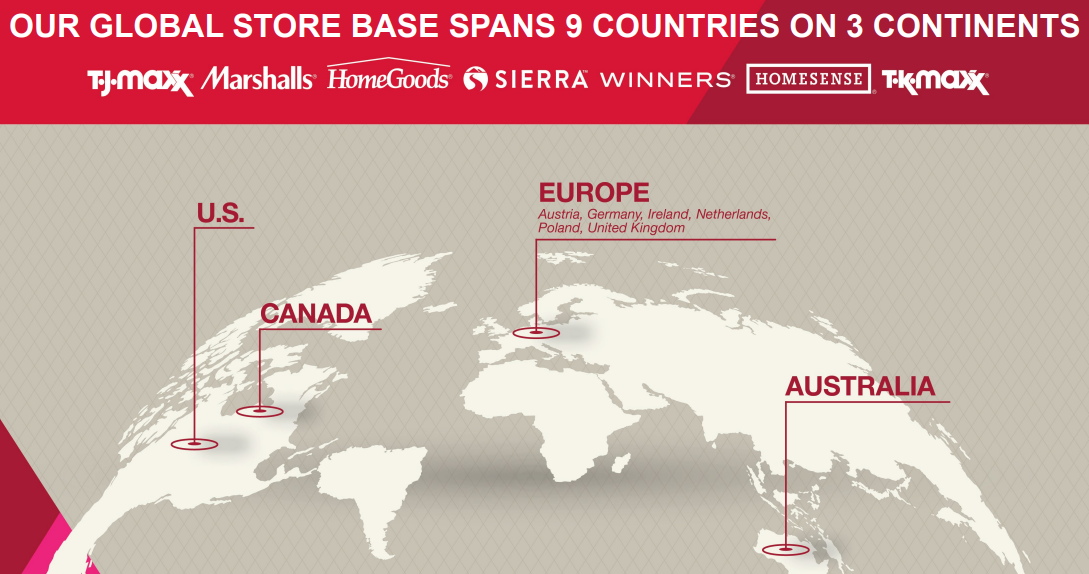The TJX Companies operates seven banners, each with its own distinct characteristics, despite their similar general orientation.
Marshalls and TJ Maxx get unwanted merchandise from suppliers to sell them at steep discounts to their initial wholesale price. They focus on a range of classic clothing items, while Sierra specializes in outdoor wear. HomeGoods focuses on home furnishings, and is complemented by Homesense, which concentrates mainly on home decoration. Winners is a generalist retailer targeting the Canadian market, while Tk Maxx focuses on the European and Australian market.
Group overview (source: TJX)

The United States is the company's primary playing field (77% of sales). Europe contributes 12% of sales, Canada 10%, while Australia accounts for just 1%.
Without question, TJX is number one in the United States (source: Statista).

A retailer focused on the middle class
TJX follows a rather conventional approach. Its essence lies in offering products at reduced prices, typically 20% to 60% less than those found at online or traditional retailers. As a result, the company's earnings have logically exploded in 2022, from $32.1 billion in 2021 to $48.5 billion, as households become increasingly concerned about their reduced purchasing power.
What sets TJX apart, however, is its choice of target customers. While most of its competitors focus on low to moderate incomes, TJX is more geared towards the middle class. The reason is simple: the group offers a varied product range that is not limited to entry-level products.
Limited growth potential?
As is often the case in this type of business, a large part of growth relies on expanding the number of stores in operation. TJX currently owns 4,835 stores. Nearly half of these (2,482) operate under the Marshalls and TJ Maxx ("Marmaxx") banners. In its various reports and presentations, the Group has referred to a potential estimate of the number of stores it could envisage owning in the long term, i.e. 6,275. This represents an increase of only 29.7% on the current number.
The long-term potential is not that high compared with the present (source: TJX).

TJX's territorial coverage is already very extensive, and the company's sheer size is beginning to limit its potential for expansion. The Group is already present in all US states, with the exception of Alaska. What's more, the development potential of online sales is limited (currently less than 3% of total sales). Indeed, for this type of purchase, which can be thoughtful but also impulsive, customers prefer to go to the store. Consequently, the most likely future growth is likely to come from market consolidation, i.e., acquisitions.
Solid accounts
Over the past decade, from 2013 to 2023 (fiscal year ending February), TJX has experienced significant growth. Revenues almost doubled, from $27.4 billion to $49.9 billion. However, the earnings trajectory followed a slower progression, from $2.1 billion to $3.5 billion. Profitability declined. Operating margin fell by a not inconsiderable 2.5%. This trend can be explained quite simply. Expansion into new locations has become more complex due to competition, lack of space on the outskirts of cities, real estate inflation and other factors. As a result, set-up costs are higher, and margins lower. Despite this, TJX has managed to increase its dividend - from $0.29 to $1.04 over the decade - in line with its financial capabilities.
The company faces major challenges. Inflation forces it to pay more for its supplies, but it is also forced not to pass on these costs to customers, at least to a limited extent, as this goes against the very nature of its business model. Nevertheless, higher prices have had the effect of massively attracting customers.
One excellent point, however: the management is agile. The group knows how to adapt to economic constraints, as was the case in 2020 when all its stores were closed for more than half the year. TJX even managed to maintain positive margins that year. What's more, cash is put to good use. Acquisitions are rare but carefully considered, and so far they have not disappointed. A notable example is the purchase of Marshalls in 1995. Today, Marshalls is one of the Group's pillars. Other noteworthy acquisitions include Sierra in 2012 and Trade Secret in 2015. The latter enabled TJX to enter Australia. Last but not least, the trio at the helm of operations - the CEO, the Executive Chairman and the Vice-President - are shareholders in the company. It's generally a good sign to have management skin in the game, a sign that their interests are in line with those of minority and historical shareholders.
TJX is the best-valued player in the sector in terms of PER. It is undeniable that in such a competitive sector, size is an advantage, as it favors geographic expansion, economies of scale and reputation. As a result, TJX enjoys a valuation premium over its competitors. What's more, with the exception of Ross Stores, none of its competitors can really compete, either in terms of balance sheet strength or financial results.
TJX is a quality company, but it faces major challenges. Its medium-term outlook is positive: according to UBS, earnings per share are set to rise by 10.5% a year over the next five years. However, this increase is merely in line with market trends. In the longer term, visibility is limited. The company will have to find solutions to counter the natural decline in organic growth in its market. Maximum territorial expansion capacity is fast approaching. Fortunately, management is competent, and the financial statements should provide the necessary resources for future investments.

 By
By 


